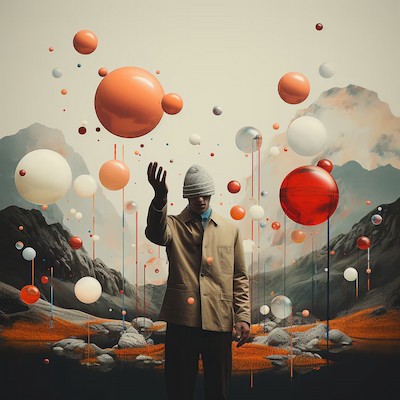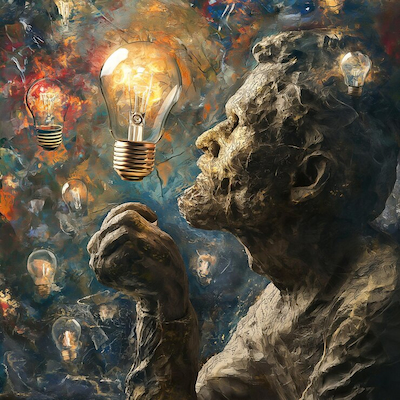
Conceptual art is a form of creative expression that prioritizes the idea or concept behind the work over traditional aesthetics or technique. It emerged in the 1960s, revolutionizing the art world by challenging established conventions and proposing new forms of interaction between artist, artwork, and audience. Conceptual art is not limited to one medium; it may be expressed through text, performance, installation, and everyday objects, bringing philosophical, social, and political questions to the forefront.
This form of art invites the public to reflect and question what is considered art, broadening creative perception. Often, the idea becomes more important than the final product, leading to a reevaluation of artistic value. In doing so, conceptual art transforms how we view artworks and how we interact with the world around us, becoming a fertile ground for innovation and new narratives.
How Conceptual Art Processes Work
Conceptual art processes involve stages ranging from idea conception to execution. The first step is formulating a concept, inspired by personal experience, social issues, or cultural movements. The artist must consider what they wish to communicate and how to present it in a way that resonates with people. This stage is crucial, as it defines the artwork’s essence and guides all subsequent steps.
Once the concept is defined, the artist chooses the medium to convey it—selecting materials, styles, and formats that best express the message. Conceptual art’s flexibility allows for the use of everyday objects or advanced technologies, creating a dialogue between concept and form.
With concept and medium established, the artist executes the work. This may vary widely in complexity, sometimes involving collaborations with other artists or professionals. Cross-disciplinary interaction is a hallmark of conceptual art, which aims to break down barriers and foster collective creativity.
Finally, the work is presented—whether in a gallery, public space, or online. Audience reception is essential because conceptual art often relies on visitor interpretation and engagement. Each person’s experience can transform the original concept, turning it into a living conversation.

Advantages of Embracing Conceptual Art
Conceptual art offers benefits that enrich both artists and audiences. One major advantage is creative freedom. By placing concept above technique, artists can explore diverse themes and forms, fostering experimentation and innovation.
Another significant advantage is social and political impact. Many conceptual works are designed to provoke reflection and dialogue on issues such as identity, inequality, and the environment. This makes art a powerful catalyst for change, capable of raising awareness and stimulating action.
Additionally, conceptual art fosters deeper connections between artist and audience. By inviting interpretation, it transforms viewers into active participants rather than passive observers, leading to a more meaningful experience that transcends aesthetics.
Finally, conceptual art expands the boundaries of what art can be. By challenging traditional definitions, artists are encouraged to explore personal ideas freely, while audiences gain exposure to a broader, more inclusive range of expressions. Thus, conceptual art plays a key role in evolving contemporary creative practices.
How Conceptual Art Functions: When the Idea Becomes the True Artwork
Conceptual art stands out for its unique approach, where the idea itself becomes the true artwork. This happens through:
-
Exploration of Concepts: Artists begin by questioning norms and definitions, using ideas as the starting point.
-
Audience Interaction: Viewers are invited to engage actively, interpret, and even participate in the work.
-
Use of Multiple Media: From installations to performances, different mediums enable diverse conceptual expression.
-
Deconstruction of Traditional Formats: The dominance of painting or sculpture is challenged, redefining what art can be.
-
Dialog and Reflection: Viewers are encouraged to question their assumptions and engage with ideas on a deeper level.
-
Social and Political Critique: Many conceptual works address pressing issues, using ideas to provoke awareness and change.
Conceptual art thus transcends visual production—it becomes a meaningful idea that resonates emotionally and intellectually with its audience.
Conceptual Art and the Power of Thoughtful Creation
Conceptual art challenges the very foundations of what we consider art to be. It does not seek to impress with technical mastery or dazzle with visual spectacle—it invites us to think. It is in this mental space, between the idea and its interpretation, that conceptual art finds its power. Artists who work within this genre engage not just in creation, but in intellectual dialogue. Their works often ask questions rather than offer answers, disrupt rather than decorate, and provoke rather than pacify.
By shifting focus from the object to the idea, conceptual art encourages a different kind of engagement—one that is internal, reflective, and often personal. This is where its true brilliance lies: in its ability to transform the viewer from a passive observer into an active participant in the creative process. The viewer is not simply looking at art—they are completing it through their own thoughts and interpretations.
For artists, conceptual practice opens infinite paths. It allows experimentation with language, time, space, and even silence. It embraces contradiction, embraces context, and often asks the most important question of all: What does this mean to you?
Ultimately, conceptual art affirms that creativity is not limited by medium or tradition—it is limited only by imagination. In a world saturated by images, art that encourages thought has never been more vital.
The Future of Art Is Conceptual
As we move further into the 21st century, where digital experiences, global conversations, and cultural hybridity dominate the landscape, conceptual art stands as one of the most resonant and adaptable forms of expression. It reflects the complexity of our times, where meaning is no longer fixed, where truth is multifaceted, and where communication extends far beyond visual representation.
The future of art is conceptual because the future itself is uncertain, nuanced, and shaped by ideas. In this future, the power of art lies not just in how it looks, but in how it makes us think. Conceptual works do not rely on beauty or permanence—they thrive on relevance, context, and critical engagement. Whether it’s a word on a wall, a performance in a street, or an empty room filled with questions, conceptual art stretches the limits of what is possible and permissible in artistic expression.
It also democratizes creativity. By emphasizing thought over form, conceptual art lowers the barriers to participation. It empowers individuals from diverse backgrounds and disciplines to contribute to cultural discourse. Everyone becomes a potential artist—not because they can paint or sculpt, but because they can question, reflect, and imagine.
In a world of rapid change and shifting narratives, conceptual art remains a compass for exploration. It asks us to look beyond surfaces and search for meaning beneath the visible. It invites us to imagine not just new artworks, but new ways of seeing, thinking, and being.

Did You Enjoy Learning About Conceptual Art: When the Idea Becomes the True Artwork?
Conceptual art invites us to shift our perception—not just of art, but of thought itself. By placing the idea at the center, it liberates creativity from the boundaries of form and tradition. If this journey into conceptual art sparked your curiosity, you’re not alone. It’s a field where every question matters more than any single answer, and where the viewer becomes part of the artwork’s unfolding meaning.
Continue exploring. Read manifestos, visit installations, or create your own idea-driven expressions. Conceptual art reminds us that imagination and inquiry are powerful forces—and that sometimes, the most profound works of art exist not on a canvas, but in the space between mind and message.
Frequently Asked Questions
What is conceptual art?
Conceptual art is about the idea behind the work rather than its appearance. It’s more focused on meaning than visual style.
How does the idea become the artwork in conceptual art?
The concept takes center stage. Whether expressed through words, objects, or actions, the idea is what matters most.
Who are major conceptual artists?
Notable names include Marcel Duchamp, Sol LeWitt, and Yoko Ono. They showed how powerful ideas can be provocative and transformative.
Is conceptual art accessible to everyone?
Yes! Anyone can engage with conceptual art. All it requires is an open mind and willingness to interpret.
Why is conceptual art important?
It challenges how we think about art, encouraging questioning and critical reflection. This makes the experience unique and enriching.

